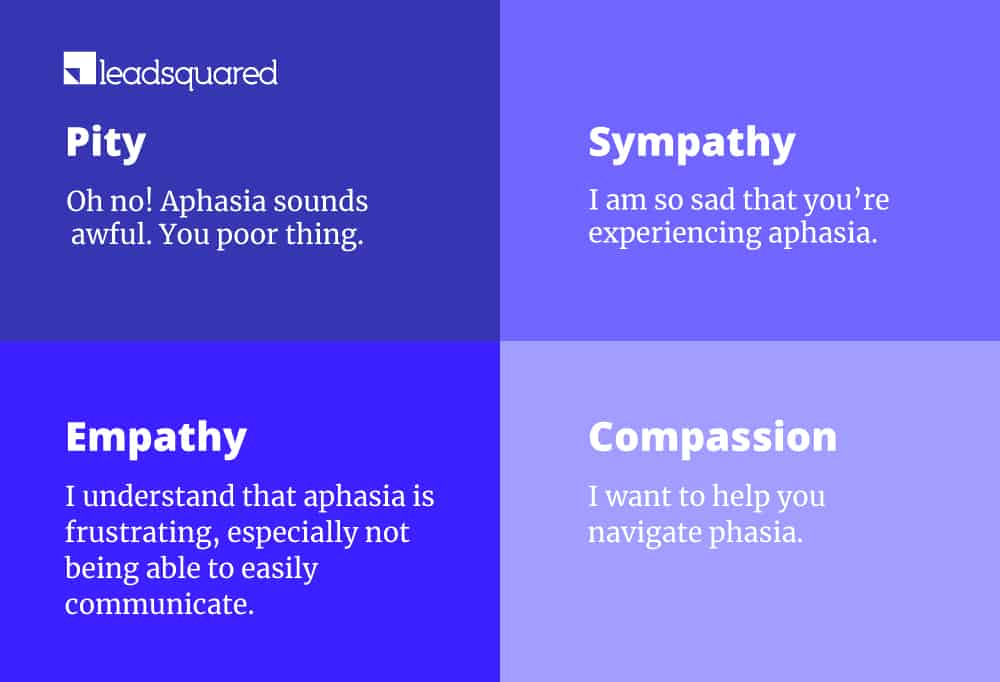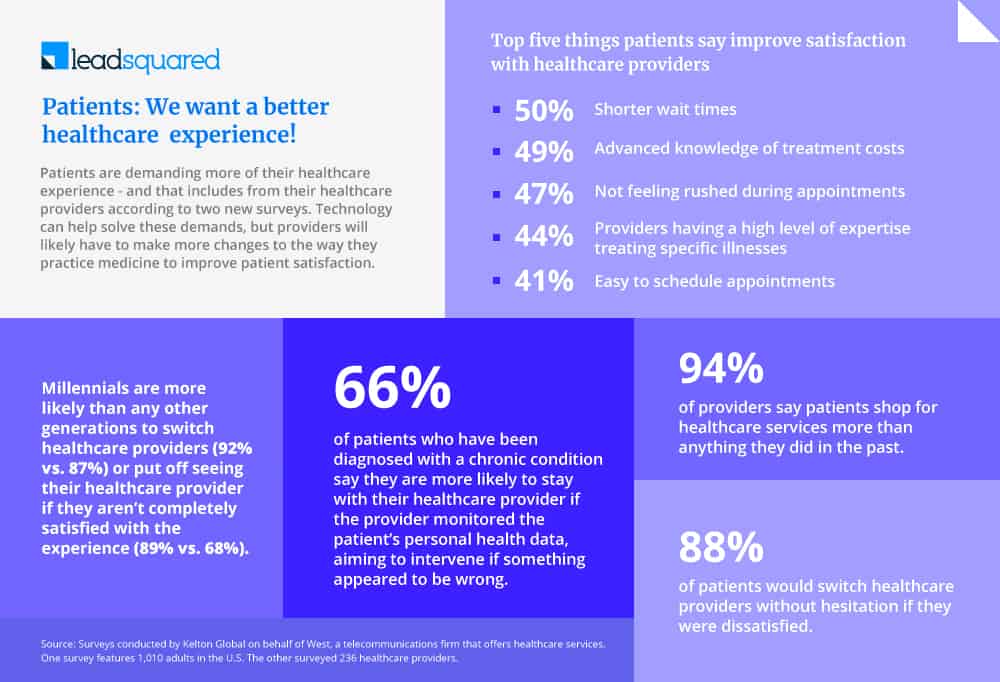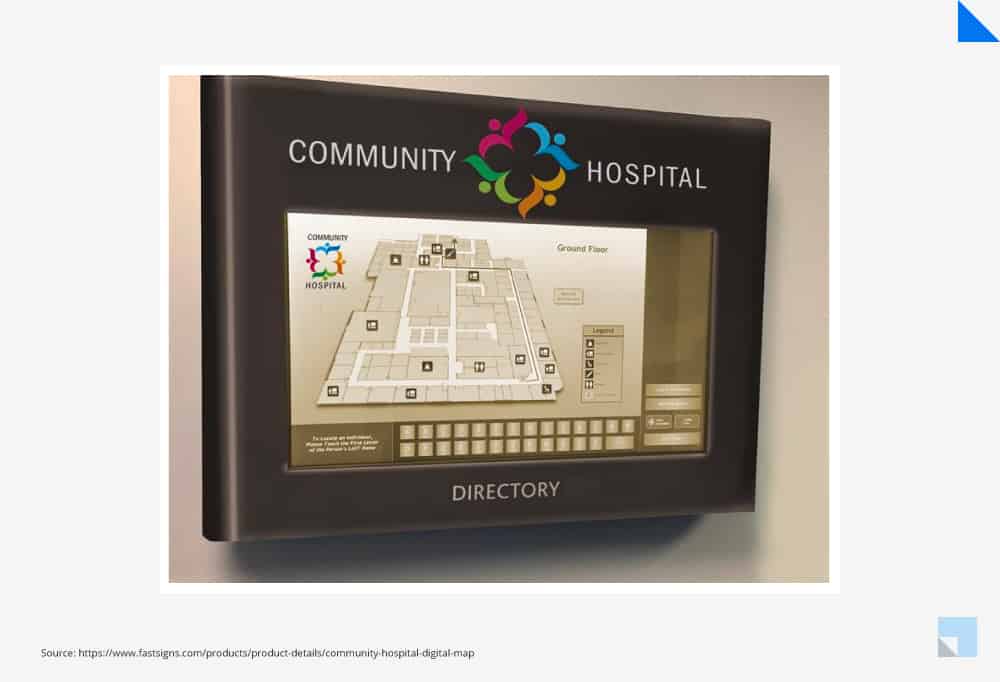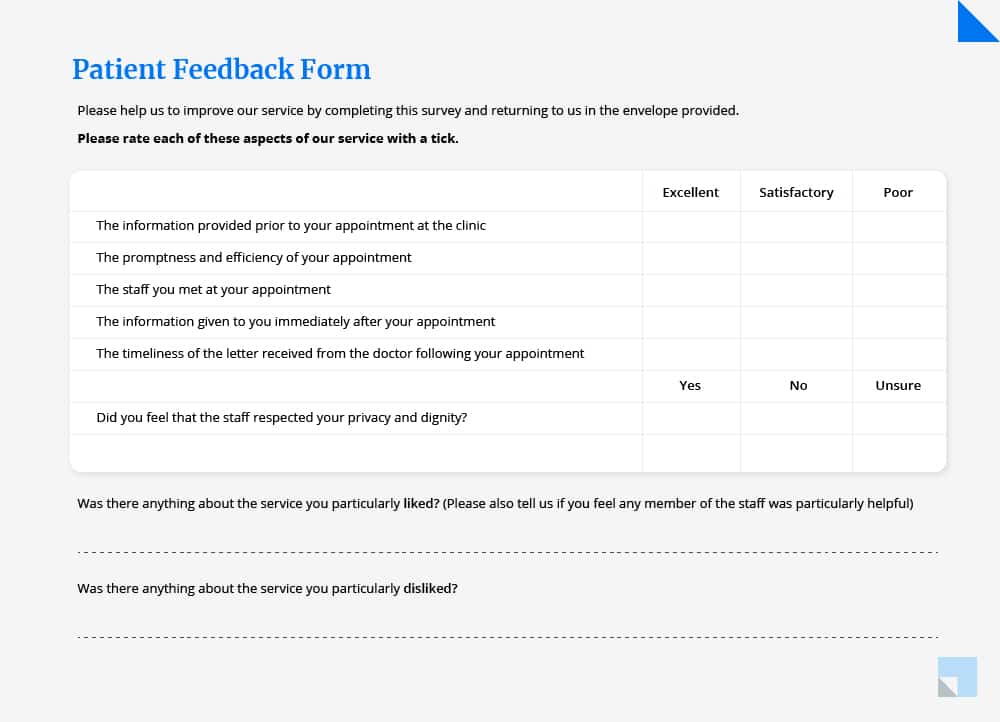- Home
- Learn
- Healthcare
- 10 Best Patient Satisfaction Survey Questions
HEALTHCARE
10 Best Patient Satisfaction Survey Questions
Contents
Patients expect more than just good medical care today. They want the whole experience to be smooth – from booking an appointment to walking out of your facility. Long wait times or rushed interactions can quickly sour that experience and send them searching for care elsewhere.
So how can healthcare providers keep up with these expectations and know what’s working and what’s not?
The answer’s pretty straightforward: ask your patients. Their feedback is one of the most valuable tools you’ve got.
This is where patient satisfaction survey questions come in. They give you honest insights into what you’re doing well and where there’s room to improve.
Let’s break down what a patient satisfaction survey really is and why it’s worth your time.
A patient satisfaction survey is a method/tool used to understand patients’ satisfaction levels and experience for the services you provide. It typically involves a series of questions designed to gather feedback on various aspects such as: the quality of care, communication with healthcare providers, wait-time, facility cleanliness, and overall satisfaction.
The feedback collected helps healthcare organizations identify areas for improvement and implement changes to ensure patient-centered care.
A patient satisfaction survey is essential for several reasons:
Patient satisfaction surveys give patients a voice to share their experiences and concerns. Organizations can accordingly address shortcomings and deliver better healthcare services by understanding their needs better.
Patient satisfaction surveys enable healthcare providers to adopt a patient-centered approach. By gathering patient feedback, you can tailor services to meet those needs and expectations and provide a more personalized healthcare experience.
Patient satisfaction surveys help you evaluate the performance of your healthcare organization. It provides data on how smooth the service delivery and interaction with the staff was. This information helps in measuring team productivity and efficiency.
Patient satisfaction surveys encourage transparency in healthcare. It ensures that you listen to patients’ concerns and are committed to providing the best patient experience.
Patient satisfaction surveys can also tell how likely patients are to recommend your services to others. This information indicates that patients who are satisfied with the service will recommend others and stay loyal to you. It helps build long-lasting relationships with patients and improve patient retention.
Before we move to survey questions, we first need to understand the metrics one needs to measure from a patient satisfaction survey. These metrics will help you draft the right questions.
Here are the metrics to measure using a patient satisfaction survey:
This metric provides an overall assessment of patient satisfaction based on their experience with the healthcare provider or facility.
Often measured using the Net Promoter Score (NPS), this metric assesses the likelihood of patients recommending the healthcare provider or facility to others.
This metric evaluates how effectively patients can communicate with healthcare providers:
This metric evaluates how clearly and effectively patients can communicate with providers. Key questions include:
Strong communication helps patients better understand their diagnosis and treatment, increasing the chances they’ll follow through with care. Consider using Yes/No questions with an option for comments to catch lingering confusion.
Use this feedback to improve communication by offering visit summaries, digital resources, or follow-up education that helps patients feel informed and supported.
Wait times at hospitals or clinics have a direct impact on patient satisfaction. Tracking this metric helps providers identify bottlenecks and take targeted action to improve the experience. You can include survey questions about time spent in the waiting room, wait times for test results, or delays in scheduled appointments.
This metric measures the level of courtesy and respect shown by healthcare staff towards patients.
Clean, comfortable environments reassure patients about the quality of their care. This includes the condition of waiting areas, restrooms, patient rooms, seating, and amenities.
Use rating scales or multiple-choice questions to assess these factors. If patients express dissatisfaction, follow up for specific details and use the insights to guide updates— be it enhancing seating, improving cleaning routines, or refreshing decor. Regularly tracking this feedback helps maintain a welcoming space and supports long-term satisfaction.
This metric evaluates how clearly providers communicate and coordinate care, especially after a visit. Ask patients if they received clear follow-up instructions, were informed about medication changes, and felt involved in treatment decisions.
Post-visit communication is just as important. Use survey scales and open-ended questions to understand how easily patients can get answers to their concerns or follow-up questions. Gaps in this area can affect both satisfaction and health outcomes.
Review feedback to improve responsiveness across channels—phone, email, patient portals, or even live chat. Timely, clear communication builds trust and reinforces continuous care.
This metric measures patient satisfaction with the accessibility and convenience of healthcare services. You can include questions about the appointment scheduling process, ease of getting through to the provider’s office, and availability of convenient appointment times.
Clear billing and insurance communication reduces patient stress and confusion. Use survey questions to gauge whether patients understood their costs, received upfront estimates, and felt supported by staff in navigating insurance details.
Identify where patients feel unclear—confusing bills, vague pricing, or complex terminology—and simplify communications accordingly. Provide written breakdowns, train staff to handle common questions, and ensure patients know where to turn for help.
Pro tip: Use automated reminders for upcoming payments and insurance confirmations. A CRM like LeadSquared can streamline patient communication and minimize billing related errors or hiccups.
Having understood the important metrics, let’s now look at the 10 best patient satisfaction survey questions you can use for your healthcare practice.
You need to ask the right questions to effectively track your drawbacks. So here are the top patient satisfaction survey questions to include in your feedback form.
(Note: We will present the patient survey questions and explain why each one matters.)
Please rate your experience on a scale of 1 to 5.
1 — Very difficult
2 — Somewhat difficult
3 — Neutral
4 — Easy
5 — Very easy
Ask your patients how easy it was to book an appointment at your clinic or hospital. The simpler the booking process, the higher the patient satisfaction.
Patients who found booking difficult can offer valuable insights into where your process may be falling short. Consider adding a follow-up question to find out exactly what they didn’t like.
One of the most obvious ways to improve patient satisfaction is to make it simple to book an appointment.
Start by offering online booking directly through your website — something quick, mobile friendly and easy to use, so patients can schedule appointments without having to make a call. Use patient portals and digital forms to collect basic information upfront, making the process even more seamless.
A good healthcare CRM (Customer Relationship Management) platform like LeadSquared brings together all these features – and more – into one system to make appointment scheduling simple and seamless. Think of it as a smart assistant that helps your team manage patient interactions more efficiently.
For instance:
Small touches like these can go a long way in how well patients perceive your service.
Please rate your experience on a scale of 1 to 5.
1 — Not at all empathetic
2 — Slightly empathetic
3 — Somewhat empathetic
4 — Empathetic
5 — Very empathetic

An independent public opinion survey found that 64% of patients wish healthcare providers took more time to understand them.
When patients feel unheard, they’re more likely to be dissatisfied – and may even switch to another provider. To avoid this, make sure you include this question in your healthcare surveys.
Tip: Train your staff to be caring and dedicated to patients.
Please rate your experience on a scale of 1 to 5.
1 — Much longer than expected
2 — Longer than expected
3 — About what I expected
4 — Shorter than expected
5 — Much shorter than expected
Reducing waiting times is a top priority for any healthcare organization.
Your wait time should match — or even outperform — your industry average. For instance, it was found that patients spent an average of 14.3 minutes in the waiting rooms of primary care practices before they could see the doctor. So, if you are a primary care practitioner, bettering this wait time can help you improve patient experience and put you above your competitors as the better choice. The same applies to specialty care practices as well.
Including a question about wait times in your patient satisfaction survey can give you valuable insights you need to work on behalf of.

If long wait times are an issue, healthcare workflow automation can help smooth things out.
Use a HIPAA compliant appointment scheduling system to minimize no-shows and improve patient flow.
Manage recurring patients and set up timely reminders for patients to ensure availability.
Please rate your experience on a scale of 1 to 5.
1 — Very dissatisfied
2 — Dissatisfied
3 — Somewhat satisfied
4 — Satisfied
5 — Very satisfied
Healthcare organizations often recommend doctors based on available data or specific patient needs. However, the recommendations aren’t always perfect. Including a question about this in your patient surveys can help you identify gaps in your patient-doctor mapping process.
H4: Tip to automate and map doctor-patients:
Use your CRM to map patients to doctors – either based on their preferences or your recommendations. Using the patient inquiry form, you can automate this mapping b by factors like region, availability, specialty, and medical history.
Map patients to doctors of your or their choice using distribution mechanisms in CRM. Using the patient inquiry form automate on the mapping on the basis of region, time, specialty, medical history.
Please rate your experience on a scale of 1 to 5.
1 — Very difficult
2 — Difficult
3 — Somewhat easy
4 — Easy
5 — Very easy
Patients often lose valuable time in finding the right doctor’s cabin or the X-ray room in a facility – and staff may not always be available to guide them. Improving facility navigability improves patient satisfaction, reduces response times, and speeds up care delivery.

Tip: Use signs and maps to help patients find their way.
Please rate your experience on a scale of 1 to 5.
1 — Very dissatisfied
2 — Dissatisfied
3 — Neutral
4 — Satisfied
5 — Very satisfied
Sometimes, patients may have negative experiences with doctors. If certain doctors are harming your facility’s reputation, it’s a signal that a change is needed.
Tip: To address this, focus on onboarding the right doctors. Also ensure that appointment schedules allow enough time for meaningful patient interactions – so doctors can listen, understand, and care without feeling rushed.
Please rate your experience on a scale of 1 to 5.
1 – Not addressed at all
2 – Poorly addressed
3 – Neutral
4 – Well addressed
5 – Fully addressed
Resolving all your patient queries is essential to delivering a good experience. A patient dealing with health concerns will naturally feel uneasy if their questions go unanswered. Addressing their doubts promptly builds trust and improves overall satisfaction.
Tip: Your website is the best place to answer all common patient questions—and with tools like chatbots, you can do it 24/7. For example, a chatbot can instantly respond to queries like clinic hours, insurance accepted, or how to prepare for an appointment, without needing staff to step in.
Please rate your likelihood on a scale of 1 to 5.
1- Very likely
2- Likely
3 – Somewhat likely
4 – Unlikely
5 – Very unlikely
Your website is the best place to answer all common patient questions—and with tools like chatbots, you can do it 24/7. For example, a chatbot can instantly respond to queries like clinic hours, insurance accepted, or how to prepare for an appointment, without needing staff to step in.
1- Very likely
2- Likely
3 – Somewhat likely
4 – Unlikely
5 – Very unlikely
It’s something you need to ask all your patients. For one, it gives you an insight into the overall impression they have of your practice.
This question directly helps you discover how your patients feel. If someone is ready to recommend your practice, then obviously you are doing a good job.
(5 being the highest rating)
a) 1
b) 2
c) 3
d) 4
e) 5
Rating is another direct way to measure patient satisfaction. If someone gives you a bad rating, you can ask them to specify the reason. You can allow the surveys to be anonymous so that patients are comfortable sharing their honest view.

This open-ended question gives patients space to share honest feedback about what’s not working. Include a blank field for detailed responses.
When reviewing responses, look for recurring themes like scheduling issues, unclear billing, or communication breakdowns. Then take targeted actions, which can include:
Tip: Take cues from patients to enhance the patient experience.
When done right, patient satisfaction surveys become great tools for improving care and growing your practice. Here’s how to use them effectively:
Cover all stages of the patient journey, from booking to follow-up. Use a mix of rating scales and open-ended questions to gather both data and direct feedback.
Send surveys via email, SMS, or patient portals using HIPAA-compliant tools. Make it easy and secure for patients to respond when it suits them.
Look for patterns in responses—common concerns often include appointment scheduling, wait times, communication, staff interaction, facility comfort, and billing clarity.
Share findings with your team and prioritize changes. Long wait times? Reevaluate your scheduling. Confusing communication? Train staff on clear, patient-friendly messaging.
Show patients their input matters. Share brief updates on improvements through your website, email, or during visits to build trust and show accountability.
Foster a team mindset where feedback is seen as a chance to grow. Celebrate wins and keep improving together.
These best practices help create a patient-centered environment that’s attentive and continually improving.
AI is nearly changing everything, and it’s amazing how you can use it to improve the efficiency of your daily work. If you want to create your own personalized patient satisfaction survey questions, you can try doing it through a good AI tool like ChatGPT.
You can use it to build case specific questions to measure satisfaction for IPD and OPD patient separately. Below are a few prompts to get you started:
Prompt 1:
Generate 10 patient satisfaction survey questions specifically for outpatient (OPD) services, each with a 1 to 5 rating scale – from 1 (very dissatisfied) to 5 (very satisfied).
Prompt 2:
Create 10 survey questions to assess the quality of post-operative care and support provided by the hospital, using a 5-point scale for responses – from 1 (very dissatisfied) to 5 (very satisfied).
Prompt 3:
Write 10 patient satisfaction survey questions focused on inpatient (IPD) experiences, with answer options rated on a scale from 1 (very dissatisfied) to 5 (very satisfied).
Be creative and create different surveys for different departments to understand the exact problem statement and improve patient experience.
HIPAA Compliant Healthcare CRM like LeadSquared can automate the whole process of collecting patient feedback. You can send feedback forms and surveys via emails, text, or notifications on channels of your patients’ choice.
It also helps track answers to your patient satisfaction survey questions. You can manage customer interactions and perform better healthcare marketing.
You can even automate your operations, patient management, and a plethora of tasks. Get in touch with us to know more about how LeadSquared can help your healthcare business grow.
Patient satisfaction score is the metric used to understand the satisfaction level of patients for the care provided. You can measure it using patient satisfaction surveys where patients rate their experience on a scale of 1-5.
Yes, patient satisfaction is a key performance indicator (KPI) for healthcare organizations. It reflects how well patients feel cared for—from service quality to staff interaction—and directly influences your practice’s growth and success.
Satisfied patients are more likely to follow treatment plans, return for future care, and recommend your services. High satisfaction drives loyalty, improves outcomes, and builds a strong community reputation.
The Net Promoter Score (NPS) is a single-question metric that measures how patients feel about your healthcare organization and the services it offers. The usual question asked is: How likely are you to recommend [hospital name] to a friend, family or colleague? It also acts as an important indicator for the growth of your practice.
Great question. Patient satisfaction surveys give providers direct insight into how patients feel about their care. From appointment scheduling to how well providers communicate, surveys uncover what’s working and where improvements are needed.
You’ll want to cover various stages of the patient’s journey. That means asking about appointment scheduling, wait times, staff professionalism, communication clarity, billing transparency, and follow-up care. Including both rating scale questions and open-ended responses helps you gather measurable data and personal insights.
There’s no one-size-fits-all here. Many practices send surveys after each visit, while others might do it quarterly or annually. The key is consistency. Timely surveys—ideally right after a visit—capture the experience while it’s still fresh in the patient’s mind.
A good healthcare CRM (Customer Relationship Management) platform can make a huge difference. Here’s how:
Automated survey delivery: CRMs let you automatically send surveys via SMS, email, or patient portals after appointments.
Patient tracking: They keep a log of each patient’s responses over time, so you can spot patterns, track satisfaction trends, and personalize care accordingly.
Smart segmentation: You can tailor surveys based on patient type—like new patients, surgical patients, or follow-ups—which helps you gather more relevant insights.
Retention tools: Some CRMs let you trigger follow-ups if a patient shares negative feedback, helping you resolve issues before they escalate.
There’s a lot more than just surveys. For instance:
Automated appointment reminders reduce no-shows and make scheduling easier.
Patient portals offer 24/7 access to health records, test results, prescriptions, and secure messaging—all of which empower patients and cut down on phone tag.
Streamlined communication: Whether it’s appointment updates, post-visit instructions, or billing reminders, a CRM ensures patients get timely, consistent information.
If the survey is short, clear, and easy to access – yes, many will. Timing also matters. Sending the survey right after an appointment and offering a mobile-friendly option helps increase response rates. Plus, if patients know their feedback leads to real improvements, they’ll be more likely to engage.
Feedback is most valuable when it leads to change. Use it to train staff, adjust workflows, enhance facilities, or update communication protocols. And don’t forget to close the loop, let patients know you’ve heard them and are making improvements based on their suggestions.
Absolutely. CRMs like LeadSquared let you stay in touch consistently—whether it’s through check-in messages, birthday wishes, or reminders for annual exams. These little touchpoints show patients you care beyond the visit, which builds trust and keeps them coming back.
Also read: